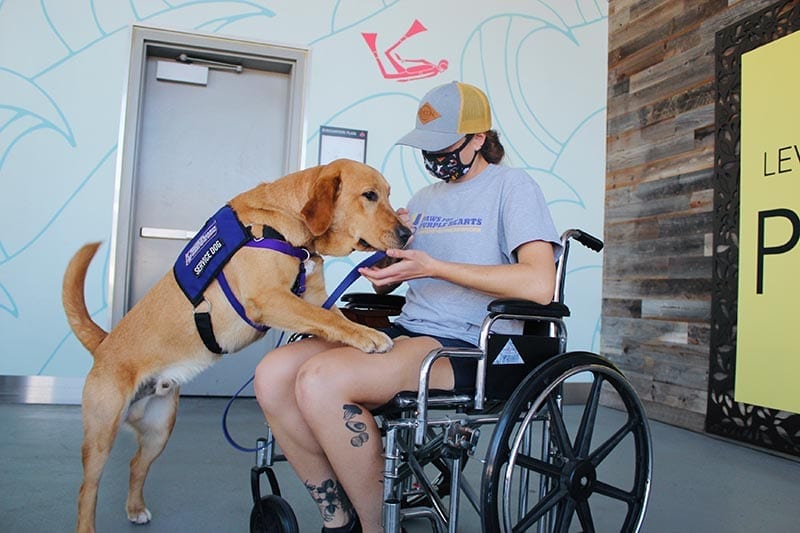Service dog versus Emotional Support Dog
At Paws for Purple Hearts we work every day with dogs to dramatically improve the lives of America’s injured Warriors. Our dogs are very special. Of course, ALL dogs are special in their own way. For at least 16,000 years, dogs and humans have maintained an unparalleled bond. Research has shown looking into a dog’s eyes releases the love hormone oxytocin, and petting the dog lowers the stress hormone cortisol. Thousands of years of the human-canine bond has created an intrinsic emotional attachment to them that is felt by dog-lovers all over the world. While many enjoy that special bond with their pets, there are many that enjoy that bond on a much deeper level; people who have been matched with a Service Dog or Emotional Support Dog (ESD). Both jobs require more of the dog than the standard pet, but what is the difference?
What is an ESD?
ESD stands for emotional support dog. The ADI defines these dogs as a companion animal that provides therapeutic support to an individual with a mental health condition or emotional disorder simply by being present. The dogs are required to be prescribed by a licensed mental health professional, but not required to undergo any specialized training. They help ease anxiety and depression, provide support with certain phobias, and provide companionship

What is a service dog?
The ADI defines a service dog as a dog that has been individually trained to perform tasks that assist disabilities other than blindness or deafness. These dogs focus on specific tasks that they are trained for to mitigate particular disabilities. They are generally allowed anywhere in public with their handler so that they can provide the proper assistance. Service dogs are considered working animals, not pets. They help with tasks including but not limited to alerting to a medical crisis, providing assistance in a medical crisis, retrieving, and bracing.
The key differences

Our Volunteer Phil with Atte in training.
As mentioned above, all dogs provide us some sort of emotional connection, regardless of their status as an emotional support dog or a service dog. The key difference is that service dogs undergo specialized training for specific disabilities. They cannot be considered a service dog if they simply provide emotional comfort. Many tasks completed by emotional support dogs (ESDs) are considered instinctual tasks, such as cuddling someone on cue, but the ability to complete these tasks doesn’t qualify them to be considered a service dog. Some ESDs do go through specialized training for specific mental illnesses, but they are not doing the same tasks or training as service dogs.
How does the title affect you and the dog?
There are many restrictions that the public has on dogs, but service dogs and ESDs are allowed to bypass these restrictions in some cases. A lot of housing now requires a pet deposit, but under the Fair Housing Act, people cannot be discriminated against based on their disabilities. The law protects them from having to make extra payments or accommodations to house their dog with them. The Air Carrier Access Act (ACAA) was recently tightened up and now draws a stricter distinction between a service dog and an ESD. In January, 2021 a final rule was issued to allow service animals to fly with their handlers, but ESD’s are now considered normal pets during flights, and therefore receive no special accommodation. At Paws for Purple Hearts our focus is service dogs, both for mobility and post-traumatic stress (PTSD). The care that our dogs provide to Warriors vastly improves their quality of life.





 Combined Federal Campaign (CFC) #43093
Combined Federal Campaign (CFC) #43093